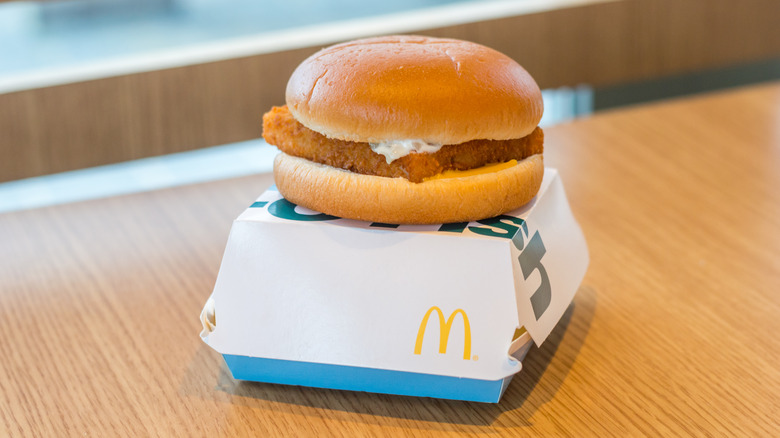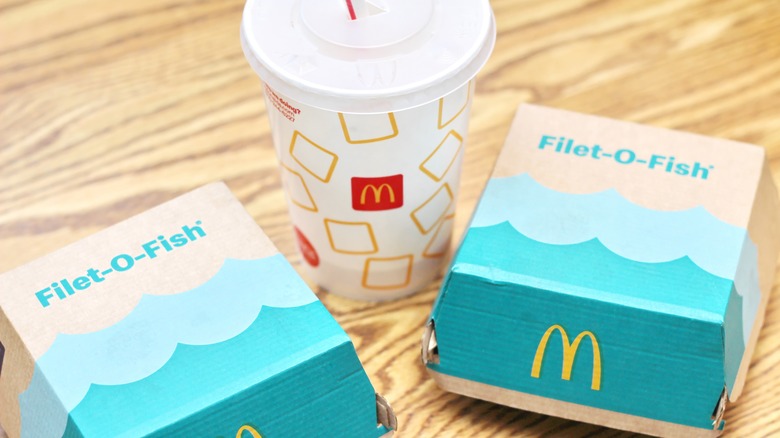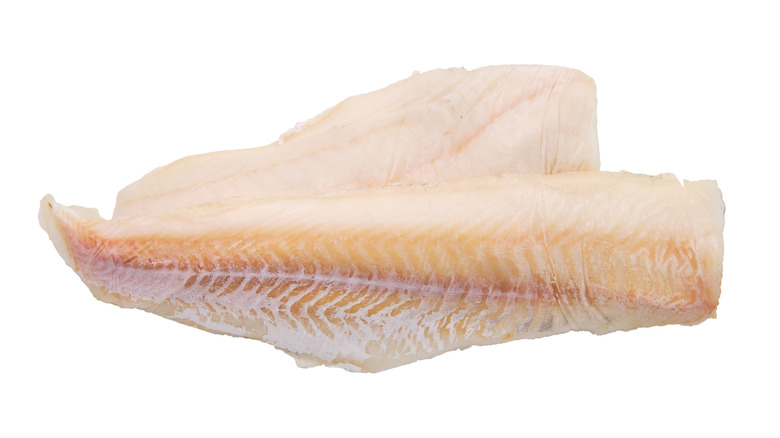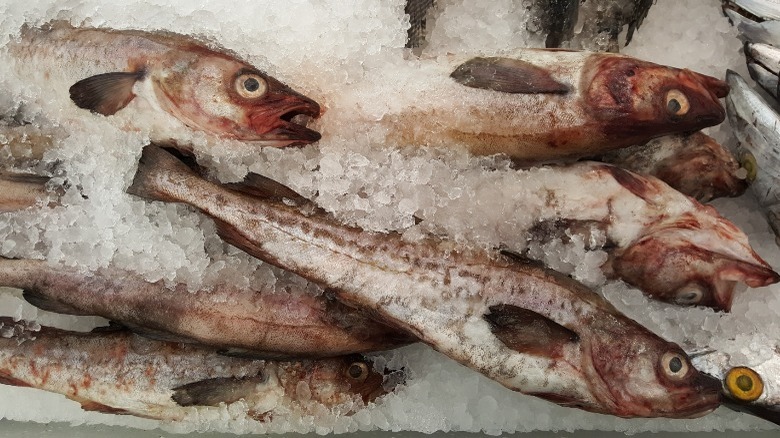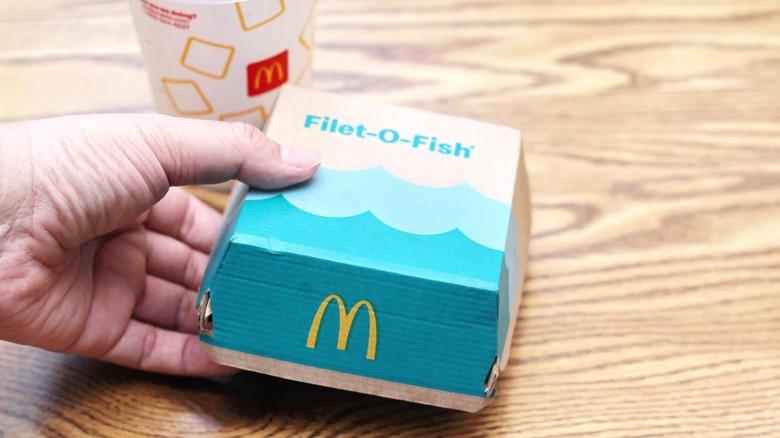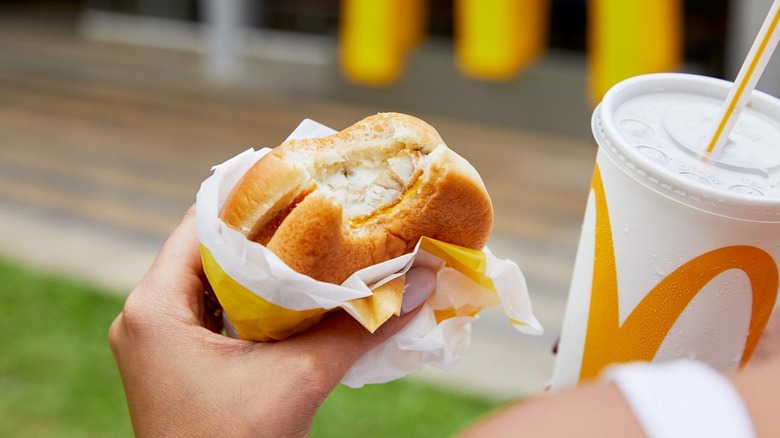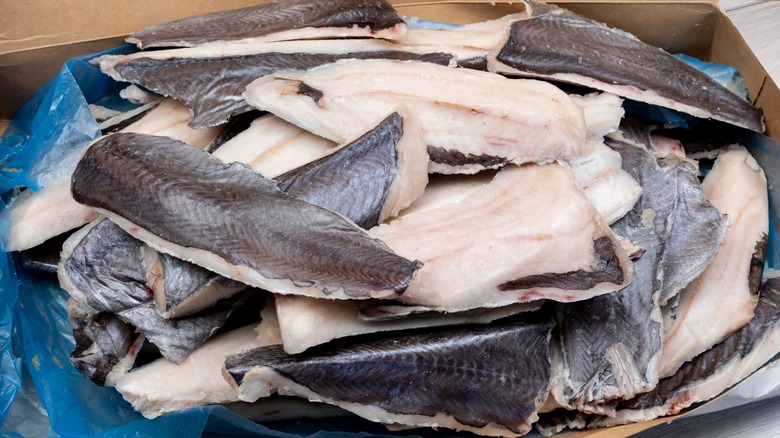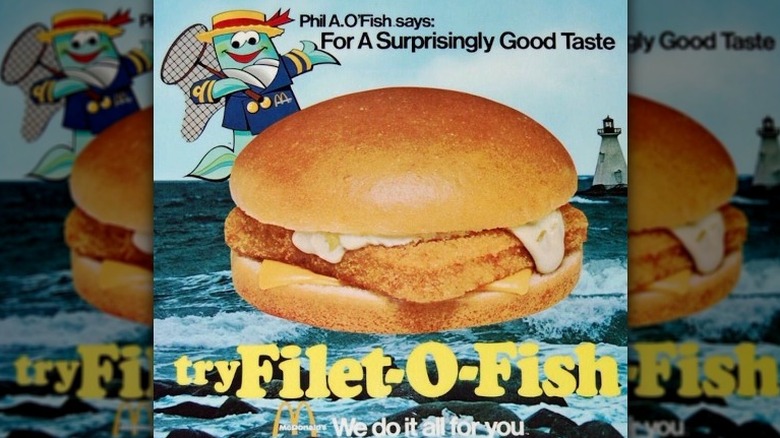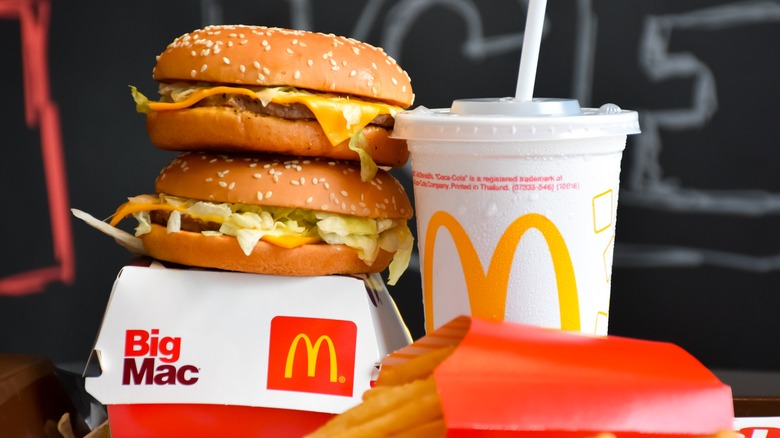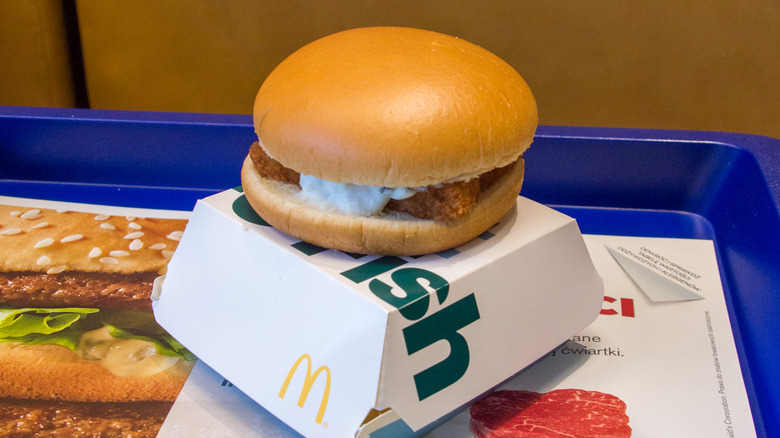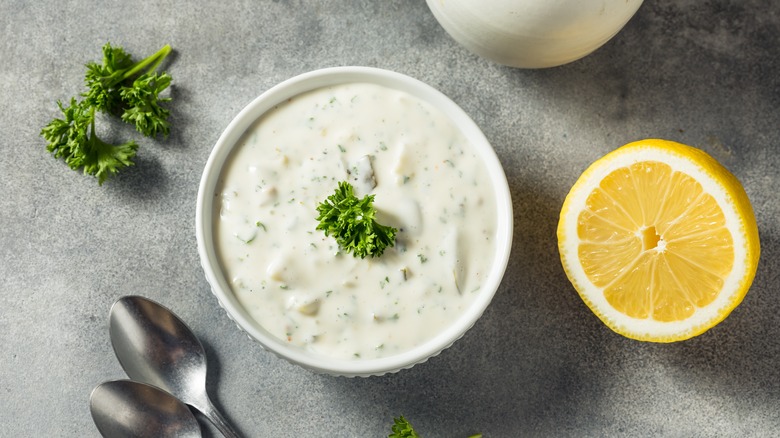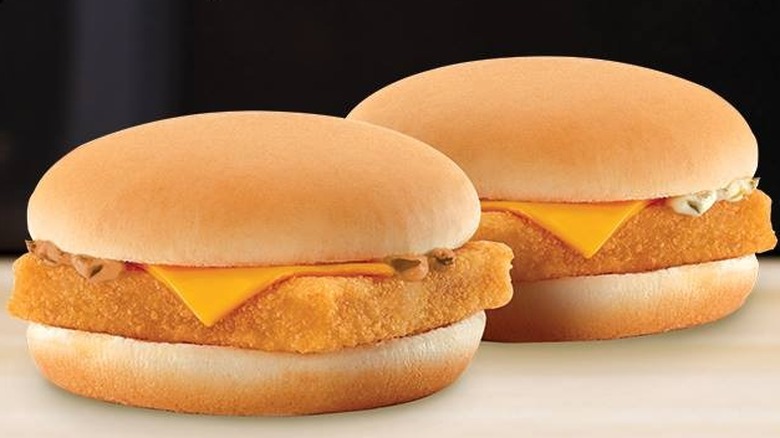Everything You Need To Know About McDonald's Famous Filet-O-Fish
With currently 13,438 restaurants in the United States, according to Global Data, McDonald's is quite popular. When you think of this famous fast food joint, chances are, you imagine a burger and fries. Or perhaps the golden arches bring to mind the happy meal, a seminal childhood favorite.
No matter what you imagine, one thing is for sure: The restaurant has changed significantly since its earliest days. For fish lovers, one of the most significant changes came in the form of the classic and beloved Filet-O-Fish. This sandwich includes a seamed bun, half a piece of cheese, a square fish patty, and tartar sauce. While delicious, the Filet-O-Fish comes out of the sheer need to offer a meat-free sandwich. This diversification not only fulfilled that requirement but also introduced a delightful sauce to customers, as well as a fabulous, soft steamed bun.
There's plenty to know about this sandwich, and since Mental Floss says it sells over 300 million sandwiches each year, it's clearly popular. With everything from its interesting beginnings to its tasty customization offerings and the sustainability of the fish, the famous Filet-O-Fish sandwich is just as scrumptious as it is fascinating.
It was created as a response to meatless Fridays
In 1962, most McDonald's regulars would know the restaurant is largely burgers and fries. And most days of the week, that's certainly not a problem, but for Catholics on Fridays, that meant McDonald's was a place they largely avoided. No one knew this better than Lou Groen.
USA Today shares that McDonald's franchisee owner Groen was struggling to keep his business afloat in the 1960s, and it was mainly due to the dip in sales his franchise experienced each Friday when Catholics were avoiding meat and McDonald's offerings. At that time, most Catholics abstained from meat each Friday rather than just during Lent, so this presented a big problem to Groen, whose surrounding population and customer base was 87% Catholic. A Catholic himself, Groen knew he needed a solution. He knew that the local Frisch's offered a fish sandwich that did so well, its own tartar sauce was for sale in pint-sized jars. So, Groen invented his own sandwich and brought it to McDonald's headquarters. Little did he know, Ray Kroc, McDonald's chief, already had his own meat-friendly version in mind.
McDonald's nearly added a pineapple sandwich to its menu
As Smithsonian Magazine tells it, Kroc wasn't initially too keen on the idea, even berating Groen and saying that he didn't want the restaurants being stunk up with a fishy smell. And while anyone who has ever microwaved fish will tell you that Kroc's concerns may have been legitimate, he was also preparing a sandwich to serve a similar purpose.
While Groen's version was fish-based, Kroc had more of a fruit-based idea. With pineapple and cheese between a bun, Groen called his sandwich the "Hula Burger" and challenged Groen to a contest. To settle the contest, Kroc put the Hula Burger and the fish sandwich on menus in a few locations on the Friday before Easter, which Catholics celebrate as Good Friday. Whichever one sold more would become the menu addition. In the end, the score wasn't even competition, and Groen's sandwich outsold Kroc's significantly. The Hula Burger was purchased only six times on that fateful Friday, while Groen's fish sandwich was sold 350 times.
The fish has changed a few times
Groen was certainly on to something, and his invention continues to address the same concern Groen had all those years ago. USA Today calculates that roughly a quarter of Filet-O-Fish sales happen throughout the season of Lent, showing that Groen was absolutely spot on when identifying this problem. However, the recipe has changed since the beginning.
Groen's first fish sandwich actually used halibut, which NOAA Fisheries classifies as a flatfish. In fact, it is the biggest of all flatfish species and can weigh 500 points and be 8 feet long. However, as Groen explained to USA Today, this fish was too expensive to use since each sandwich cost 30 cents, and Groen had been told that the sandwich needed to sell at 25 cents. At that point, he needed to switch to cod and added cheese as a supportive flavor. Eventually, that fish changed again to sustainable Alaskan pollock.
There are real ingredients in this sandwich
When checking out the ingredients listed by McDonald's, you'll notice that the first item listed is pollock. This fish, also called the Walleye Pollock by NOAA Fisheries, is caught in the North Pacific Ocean and the Eastern Bering Sea. Perhaps one of the reasons this fish is so agreeable to diners is that it is a member of the cod family and can even grow up to 3 feet in length. However, it's a pretty lightweight fish, weighing only 1 pound to 3 pounds. Thanks to the very fertile fish, populations are rather abundant for fishing.
Genuine Alaska Pollock Producers (GAPP) states that the Alaskan Pollock is so popular that it is consumed more than most other fish in the United States. Plus, this fish is something like a superfruit of the sea with meat that is low-fat and high in heart-loving fatty acids like omega-3. Not to mention, it is high in vitamin B-12. GAPP touts the fish's flexibility in the different foods you can find it in between fish tacos and fish sticks to fish sandwiches like McDonald's Filet-O-Fish.
The fish is from sustainable fisheries
If environmentalism is at the top of your values, you'll be pleased to know that McDonald's ensures that it uses only wild-caught Alaskan Pollock fish from only sustainable fisheries in its United States Filet-O-Fish sandwiches. Genuine Alaska Pollock Producers (GAPP) says that these fisheries operate out of Alaska's Bering Sea. So, when you enjoy a Filet-O-Fish sandwich, you can rest assured that this fish comes from a very large certified sustainable fishery, making this fish certified sustainable seafood.
In addition to getting fish through these sustainable fisheries, McDonald's is active in GAPP, participating in its annual meeting. In October, McDonald's Director of Global Fish and Pork Sourcing, Jason Cervone, discussed the latest in McDonald's efforts to ensure the Filet-O-Fish continues to be a popular and beloved sandwich. These efforts to ensure that McDonald's maintains a strong partnership with groups like GAPP show McDonald's commitment to ensuring its sources of fish is sustainable and helps protect the environment.
It's a great source of protein
Livestrong argues that the nutritional content of the Filet-O-Fish isn't great, but the sandwich does provide a nice helping of protein. According to the McDonald's menu, the whole sandwich comes to 390 calories. It has 19 grams of fat, but that extra fatty goodness is one of the reasons the fish tastes so good. Saturated fat comes in at 4 grams with 0 grams of trans fats. You'll also get 39 grams of carbohydrates to keep your energy up with 2 grams of fiber. And, most notably, the Filet-O-Fish has a solid 16 grams of protein. What's more, this fish affords you some omega-3 fatty acids to help maintain a healthy heart.
Since so many people enjoy this sandwich regularly, especially during the Lent season, it's helpful that it isn't loaded down with fat and carbohydrates without the added benefit of helping maintain a healthy amount of energy through protein.
You can customize it
When looking at the menu at a fast food restaurant, it may feel like the options are static and immovable. However, that is simply not the case. You have the ability to personalize any items on the McDonald's menu, and as long as the restaurant can accomplish your task, it will. So, for example, on days when we've wanted less salt, we're requested light salt on our french fries, and we love extra pickles on our chicken sandwich, so that's always an augmentation we make.
The Filet-O-Fish is no different. If you want an entire piece of cheese on your sandwich or no cheese at all, you can request it made that way. If toasted buns are more enjoyable for you, ask for a toasted bun rather than a steamed one. Perhaps you love that famous tartar sauce. If that's the case, you can even ask for the sandwich to be made with extra sauce. Plus, when you order customizations, you'll get a sandwich that is a little fresher than one that has been sitting premade on a warmer. This is an easy way to get the freshest food possible, but you may need to wait an extra minute or two for your order to be complete.
Different parts of the world use a different fish for the sandwich
While the United States uses Alaska Pollock to make the Filet-O-Fish sandwiches, not all other McDonald's locations throughout the world do. Whether it be for availability, affordability, or sustainability, McDonald's of the UK says that the fish for Filet-O-Fish comes from either Alaska pollock or Hoki.
As the Marine Stewardship Council explains, Hoki, also known as Blue Grenadier and other names like blue hake, the New Zealand whiptail, and even simply whiptail, comes from the waters of New Zealand and Southern Australia. There, you'll find a smooth fish that can become roughly 1.3 meters long. It's a great fish to use for a Filet-O-Fish because the meat is tender and even a little sweet. Its extra flavor comes from the increased fat, making it an ideal fish choice for breaded fish. Australian Fisheries Management Authority describes an adult Hoki's home as in generally deeper water, and the younger fish tend to hang out in more shallow water, like a bay or inlet.
Commercials for the sandwich once featured a mascot
Vintage ads are fun and give a great glimpse into a company's marketing history. In 1976, McDonald's introduced a mascot for this popular sandwich. The marketing piece from RetroNewsNow's Twitter features a smiling teal and green fish in seawater named Phil A. O'Fish with a vaguely Irish name, billed hat, and a net allegedly saying, "For a surprisingly good taste try Filet-O-Fish." There are also examples of other advertisements with the same character that even included coupons.
And while this is far from the last of the characters McDonald's will introduce, it wasn't the first either. The Ronald McDonald clown character, clad in bright yellow and red clothing, made his debut grand appearance in the 1960s. In 1971, the Hamburglar also premiered before Phil A. O'Fish and brought a villain to the company. Even the Filet-O-Fish wasn't safe from its very own storyline. In fact, the Captain Crook character enjoyed stealing Filet-O-Fish sandwiches from the residents of McDonaldland.
There are some great secret menu options
A secret menu option is a fun way to switch up your typical menu offerings for something unique. Though the term "secret menu" generally just refers to a type of offering you'll need to request customization to achieve, some secret menu options have actually found their way to the everyday menu. For example, Starbucks' Pink Drink began as an internet sensation, but, as Starbucks explains, it became an official menu item in 2017. Likewise, McDonald's also has secret menu options.
For an option that includes the Filet-O-Fish, try out the Land, Sea, and Air Burger. NPR defines this massive burger as one that has beef, chicken, and fish. While this option does not always appear on the typical menu, it sometimes pops up on menu boards as an official menu hack you can request when ordering. It's hard to say whether it will always be there, but if you want to try out this massive offering, ask for a Big Mac with a McChicken patty on top of the top burger patty, topped with a Filet-O-Fish patty and tartar sauce in place of the second burger. Reviews of this one are somewhat mixed, but it sure makes for a fun picture and a unique spin on the classic Filet-O-Fish.
It's the only sandwich to feature a steamed bun
Typically, when you order a burger from McDonald's, you're going to get a toasted bun to hold all those ingredients. However, the Filet-O-Fish isn't a typical sandwich, so its buns get a rather unique treatment to make it so delicious.
Rather than being toasted, Filet-O-Fish buns get steamed. EssentialMcDonald's on TikTok demonstrates the Filet-O-Fish being made and shows viewers that the buns go in a special steamer device for 11 seconds. This way, your fish, tartar sauce, and cheese are joined with a bun that is perfectly fitting and tastes delicious alongside the fish. You'll notice that it is incredibly soft, and if you like this feeling of the bun, you can also ask for other sandwich buns to be steamed on your next order.
If you love this kind of bun, you can also replicate the feel at home. In fact, it is a great way to make your store-bought buns tastier. Make your own steamer at home by putting some water in a pot, letting it comes to a boil, placing a colander on top, and putting your buns in the colander. Then, cover the top with a lid and allow those buns to steam for about a minute. In no time, you'll have Filet-O-Fish-worthy buns.
McDonald's has a famous tartar sauce to go with it
McDonald's tartar sauce is so popular, people have even tried to mimic it with a copycat recipe. While recreating the tartar sauce is helpful for your own fish recipes, it can also be beneficial to have on hand if your McDonald's order was just a little short on this tasty sauce. And while being able to make it at home is a tasty trick to have in your back pocket, being able to pull it from your fridge is even better.
Joining the ranks of other fast food condiments like Taco Bell taco sauce, Freddy's Burgers fry sauce, and the original Chick-fil-A sauce, Brand Eating reveals that McDonald's released bottled versions of some of its favorite sauces, including the sauces for the Big Mac, Filet-O-Fish, and McChicken. Unfortunately, these sauces were only available for a limited amount of time and, according to Reddit, seemed to disappear from grocery shelves rather quickly. While these sauces were only available for purchase in stores in Canada, you could order them from online retailers like Amazon.
McDonald's loves to experiment with the Filet-O-Fish
Even though customers love the classic Filet-O-Fish sandwich, McDonald's loves playing with even classic dishes like the Filet-O-Fish. Sparklette, a guide to restaurants in Singapore, reports that in 2008, McDonald's restaurants in Singapore were selling a Wasabi Filet-O-Fish. This sandwich offers a delicious addition to the classic recipe: the addition of a wasabi-flavored mayo. In 2012, McDonald's in Singapore announced on Facebook that this fun sandwich was coming back in 2012 in both a single and double-stacked version.
Back in the states, in February 2015, McDonald's offered an Old Bay Filet-O-Fish. According to The Baltimore Sun, this sandwich swam into only 700 restaurants across Maryland, Virginia, Delaware, and Washington. Rather than having the typical tartar sauce, the Old Bay Filet-O-Fish has a tartar sauce flavored with the classic Old Bay seasoning, a mix of several seasonings, including paprika, pepper, and celery salt. This makes the sandwich look mostly similar to the regular Filet-O-Fish sandwich but with a little more of an orange-colored tartar sauce.
